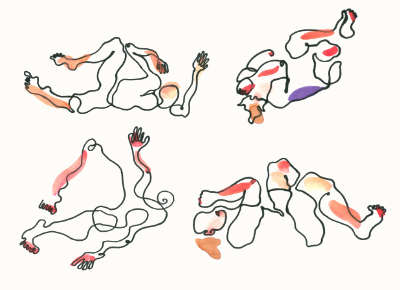What is Feldenkrais?

Illustrations by Jori Baldwin
The Feldenkrais Method® of movement education helps you become aware of your habits so you can make the choices that are best for you.
There are two ways you can learn Feldenkrais: Awareness Through Movement® and Functional Integration®. I teach in Toronto’s Leslieville, Riverdale and Annex neighbourhoods.
Awareness Through Movement lessons are usually done lying on a mat. The teacher guides your attention by talking you through a series of pleasant and gentle movements. You may recognize elements from child development, martial arts, dance or yoga in the lessons. The focus is on awareness, and on staying well within your comfort zone. Rather than concentrating tightly on one area, you spread your attention through the whole of yourself. This gives you a chance to discover deeply ingrained habits, and to create new possibilities that are safer, more sustainable, and more fun.
Movement is life. Life is a process.
Improve the quality of the process and you improve the quality of life itself.
-Moshe Feldenkrais
Functional Integration is a hands-on way of learning Feldenkrais. It is geared to your individual needs. You lie, wearing loose clothing, on a specially designed table, while the teacher guides your movements in a non-invasive way. You can use Functional Integration to attend to an injury or specific issue, or just to enhance your learning.
Who will benefit from these classes?
Anyone at any age or stage of life.
We all move; we all benefit from awareness. The purpose of this work is not to cure or fix any aspect of you or your life. It’s a matter of knowing what you’re doing so you can do what you want.
Here is an example of some of the reasons people come to my classes: dancers, musicians, athletes and actors turn to Feldenkrais to avoid injury or give themselves an extra edge. For those starting an exercise program or recovering from injury these classes are a safe and enjoyable way to get back into action. The method is especially effective for living well with chronic pain, and conditions such as arthritis, multiple sclerosis and Parkinson’s disease. Some people adopt Feldenkrais as a regular practice because it helps them feel calmer, more settled, more focused. Others feel that they do daily activities more efficiently if they take a regular class. Many people enjoy the social aspect of the classes (even remote ones), or the chance to think about something other than work.
Testimonials
There is no judgement. There is no competition. There is no such thing as doing it properly. There is no such thing as something to be achieved. To me, this method is so hopeful. No matter how incapacitated a person gets physically, there is always something that can be done in the imagination or in a part of the body that doesn’t feel pain.
– Elizabeth Evans
No matter what I’m doing – singing, dancing, walking down the street, lying in bed – I regularly find myself using what I’ve learned at Maria’s ATM lessons. Getting rid of old habits of posture and movement has been way easier with Feldenkrais technique and the understanding it’s given me of body structure and, in particular, how the skeleton is put together. The result has been more freedom of movement with less effort.
– Andrea Johnston: writer, singer, dancer